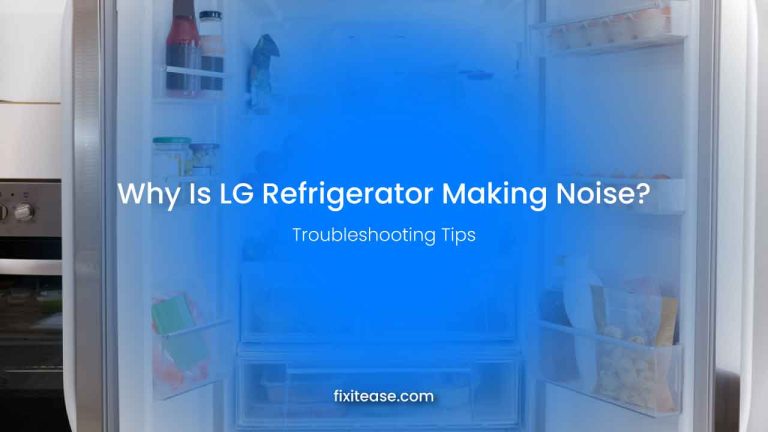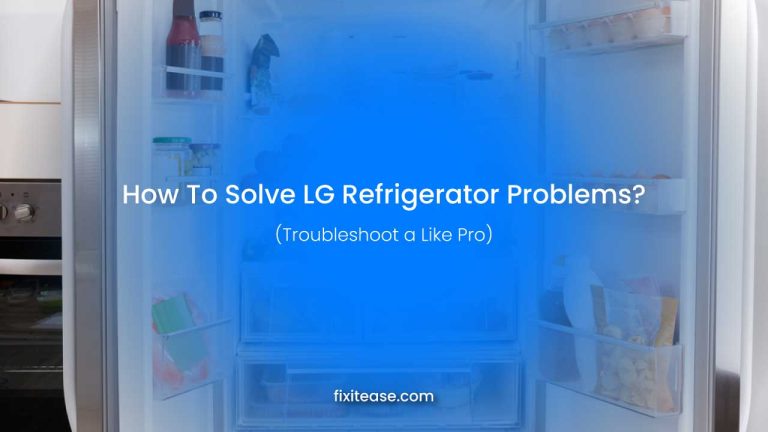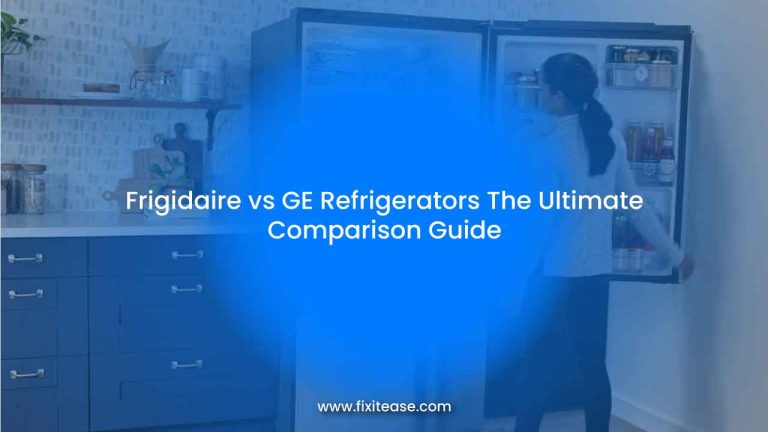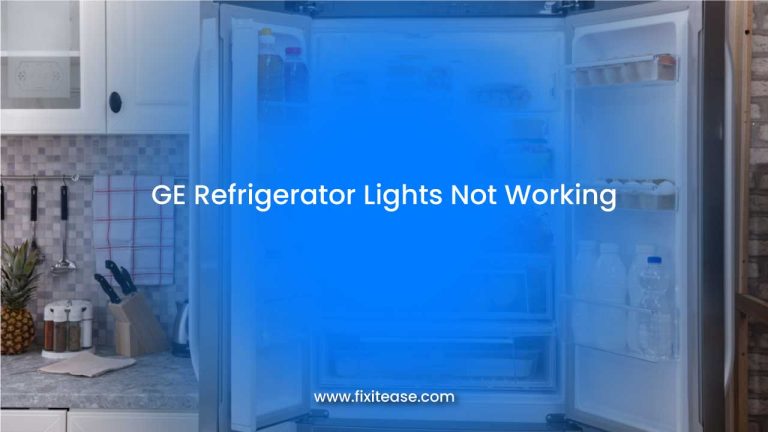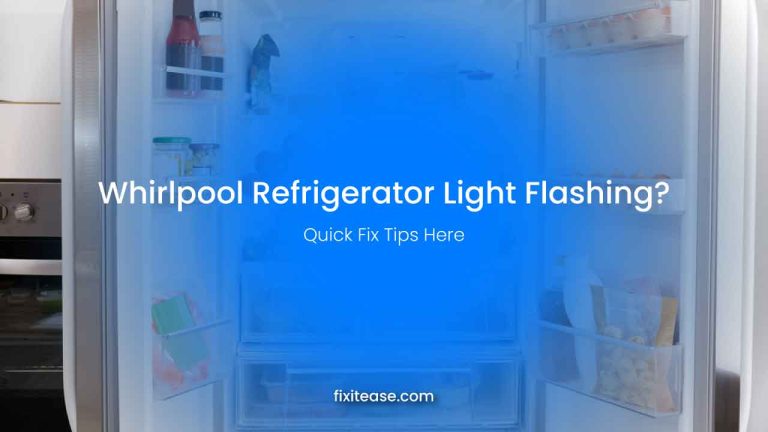LG Refrigerator Freezer Not Working: 7 Troubleshooting Tips for a Fix
When your LG refrigerator is operational, but the freezer fails to function, identifying the issue can be challenging. Potential causes may include power settings, temperature adjustments, condenser coils, freezer coils, and thermostat covers.
While there are solutions to these problems, if they are not addressed carefully, they can lead to spoiled food, melted ice cream, and potentially costly repairs. So, when your LG refrigerator freezer stops working, it is critical to identify and fix the problem as soon as possible.
This article will guide you through possible causes and solutions to get your LG refrigerator freezer up and running again. From checking the temperature settings to ensuring proper door closure, we will cover all the essential steps to troubleshoot your LG refrigerator freezer.
Why Is the LG Refrigerator Freezer Not Working? (Common LG Freezer Faults)
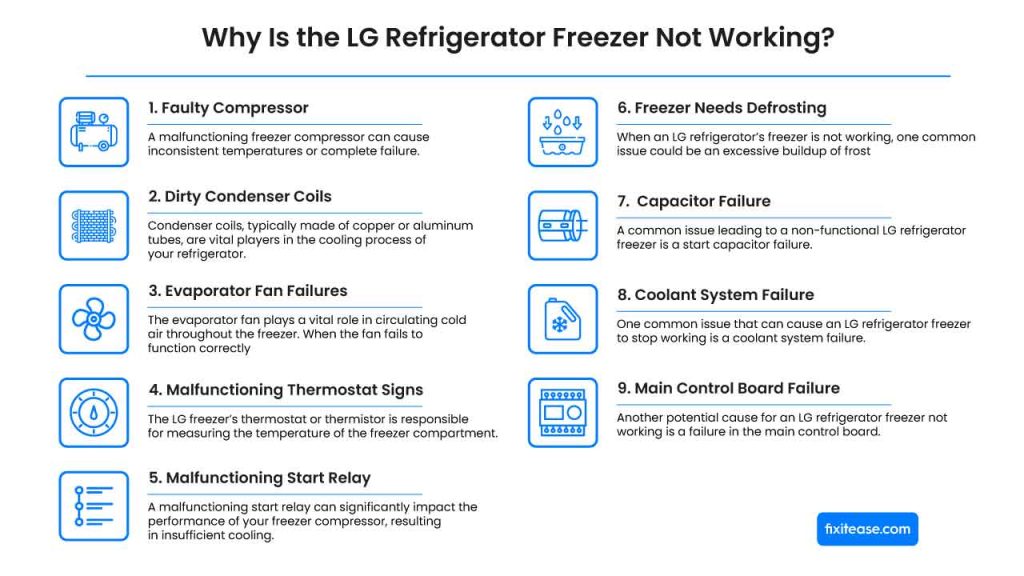
If your refrigerator isn’t working, there could be various reasons. If you’re not acquainted with refrigerator components, it’s recommended to consult a professional. But before the call, make sure to check what happened with your refrigerator.
Here are some common issues:
1. Faulty Compressor
The freezer’s compressor plays a crucial role in ensuring effective cooling by creating a low-pressure side of 0 psi and a high-pressure side ranging between 130-135 psi. When the compressor malfunctions, it can result in issues like inconsistent temperatures or complete freezer failure.
The static pressure for an LG-style refrigerator is set at 10 inches of vacuum, and significant fluctuations can lead to the freezer ceasing to operate.
Here are key signs to be vigilant for:
- Unusual noises emanating from the compressor, such as buzzing or clicking sounds.
- Inadequate cooling in the freezer, causing food spoilage.
- Frequent cycling on and off of the compressor.
- Accumulation of frost or ice on the evaporator coils.
How Can You Fix Faulty Compressor?
Perform a refrigerator reset by unplugging it or tripping the circuit breaker for 30 seconds. Wait five minutes before restoring power. In the freezer, press the light switch three times. Monitor the temperature for 24 hours to ensure proper functionality.
If you don’t see any improvements after resetting, you may need to replace the device or have it serviced by a technician.
2. Dirty Condenser Coils
Condenser coils, typically made of copper or aluminum tubes, are vital players in the cooling process of your refrigerator. It is positioned at the back or bottom of the appliance and is often referred to as refrigerator coils, they are responsible for cooling the air inside.
Their key functions involve cooling and condensing the refrigerant, releasing heat into the surrounding air, and assisting the refrigerator and freezer in maintaining their desired temperatures.
Yet, when these coils gather dirt, their effectiveness takes a hit. This can lead to problems like insufficient cooling, potentially causing overheating and an inability to freeze items properly.
Fixing Procedure:
Unplug the Refrigerator: Ensure safety by disconnecting the refrigerator from the power source.
Locate the Condenser Coils: Identify the condenser coils’ location, usually found at the back or bottom of the refrigerator.
Clean the Coils: Use a vacuum cleaner or a specialized condenser coil brush to gently remove dust and debris. Be thorough in cleaning both the coils and the surrounding area to enhance airflow.
Use Compressed Air: For stubborn dirt, consider using compressed air to effectively dislodge particles from the coils.
3. Evaporator Fan Failures
The evaporator fan plays a vital role in circulating cold air throughout the freezer. When the fan fails to function correctly, it can cause temperature imbalances and inadequate cooling. Here are some signs that your evaporator fan may be failing:
- No air circulating inside the freezer, resulting in uneven cooling.
- Excessive frost or ice accumulation on the evaporator coils.
- Loud or strange noises coming from the fan area.
- The freezer not reaching the desired temperature.
Why does it happen?
There are several reasons why an evaporator fan in a refrigerator might fail: But most of the common cases are:
- Ice build-up
- Blocked fan
- Damaged fan blade
- Defective motor
- Broken wires
Fixing Method: Regardless of the cause of the evaporator fan failure, the recommended solution is to replace it.
4. Malfunctioning Thermostat Signs
The LG freezer’s thermostat or thermistor is responsible for measuring the temperature of the freezer compartment. A working thermostat sends a signal to the freezer control board to start or stop the cooling process as needed.
If the thermostat is faulty, it may send incorrect temperature readings, causing the freezer to stay too cold or too warm, inconsistent temperature readings on the thermostat display, the compressor running excessively, and the freezer taking longer than usual to reach the desired temperature.
Unfortunately, the thermostat cannot be repaired and must be replaced.
So, how can I know if the Thermostat works fine or not?
To test the thermostat, use a multimeter to check for electrical continuity. If there is no continuity, the thermostat needs to be replaced.
Here are some additional tips for replacing the thermostat:
- Make sure to unplug the freezer before you start work.
- Disconnect the wires from the old thermostat.
- Install the new thermostat in the same location as the old one.
- Connect the wires to the new thermostat.
- Plug the freezer back in and test it to make sure it is working properly.
5. Malfunctioning Start Relay
A malfunctioning start relay can significantly impact the performance of your freezer compressor, resulting in insufficient cooling. If the compressor fails to run or turn on properly, your freezer won’t maintain the desired temperature.
Here’s a step-by-step guide on how to diagnose and fix the start relay issue:
| Steps | Solving Procedure |
| Unplug the Freezer | Safely disconnect the freezer from the power source to ensure a secure working environment. |
| Locate and Remove Start Relay | Identify the start relay connected to the compressor and carefully remove it for inspection. |
| Testing with a Multi-Meter | Use a multi-meter to assess the start relay by checking for continuity between the start and run terminals. |
| Diagnosing Continuity | If the multi-meter indicates no continuity, it signals a faulty start relay that requires replacement. |
| Replacement Procedure | Purchase a compatible start relay for your freezer’s model, disconnect any wiring, and install the new relay securely. |
6. Freezer Needs Defrosting
When an LG refrigerator’s freezer is not working, one common issue could be an excessive buildup of frost, causing the need for defrosting. This buildup can impede the freezer’s efficiency and lead to temperature irregularities.
Fortunately, addressing this concern involves a straightforward defrosting process.
Fixing Process:
- To defrost your freezer efficiently, start by unplugging the unit and removing any ice accumulation.
- Place towels in the freezer to absorb melting water and use bowls of hot water or a hairdryer/heat gun cautiously to expedite the process.
- Ensure the freezer is completely dry before powering it back on, preserving its optimal functionality.
7. Capacitor Failure
A common issue leading to a non-functional LG refrigerator freezer is a start capacitor failure. The start capacitor plays a crucial role in initiating the compressor’s startup process. When it fails, the compressor struggles to start, impacting the overall cooling performance.
Causes:
Start capacitor failure can occur due to prolonged usage, electrical issues, or manufacturing defects.
As the capacitor weakens over time, it hinders the compressor’s ability to kickstart the cooling cycle, resulting in a non-working freezer.
Fixing the Problem:
- Disconnect the refrigerator from the power source to ensure safety.
- Find the start capacitor within the refrigerator.
- Check the start capacitor for any visible signs of damage or leakage.
- Use a multi-meter to measure the capacitance. A significantly low reading indicates a failed capacitor.
- Purchase a compatible start capacitor and install it securely, disconnecting any wiring from the faulty capacitor.
- Plug in the refrigerator and observe if the compressor starts, confirming the freezer resumes normal operation.
8. Coolant System Failure
One common issue that can cause an LG refrigerator freezer to stop working is a coolant system failure. The coolant system plays a crucial role in maintaining the optimal temperature within the freezer. When this system fails, it can result in insufficient cooling and a warm freezer.
Cause:
Coolant system failure may occur due to a refrigerant leak, a malfunctioning compressor, or issues with the evaporator coils. These components are vital for the proper functioning of the cooling system.
Fixing Process:
To troubleshoot a potential coolant system failure in your LG refrigerator freezer, start by identifying the issue.
Look for visible signs of refrigerant leaks, such as oil spots or hissing sounds. Test the functionality of the compressor and evaporator coils.
If these components are found to be faulty, replacement may be necessary. Ensure the replacement parts are compatible with your refrigerator model.
For refrigerant-related issues that require professional expertise, consult with a technician to identify and address the specific problem, ensuring a thorough and accurate resolution.
9. Main Control Board Failure
Another potential cause for an LG refrigerator freezer not working is a failure in the main control board. The main control board is the electronic brain of the refrigerator, responsible for regulating various functions, including temperature control.
Cause:
Main control board failure can be attributed to electrical issues, power surges, or component malfunctions. When the control board fails, it can disrupt the entire cooling system.
Fixing Process:
To address a non-working LG refrigerator freezer, start by checking for power issues.
- Ensure a consistent power supply and inspect the cord and outlet for damage.
- Proceed to reset the control board by unplugging the refrigerator for a few minutes.
- Test the control board components with a multimeter, replacing any faulty parts.
If issues persist, seek professional assistance for a thorough diagnosis and potential control board replacement.
Frequently Asked Questions
Why Is My LG refrigerator Freezer Not Working?
There could be multiple reasons for your LG refrigerator freezer not working. Check if the temperature settings are correct, if the compressor is running, if there’s a power outage, or if the condenser coils are dirty. If the issue persists, it’s recommended to contact a professional technician for further assistance.
How Do I Reset My LG Refrigerator Freezer?
To reset your LG refrigerator freezer, locate the reset button on the control panel. Press and hold the reset button for a few seconds until you hear a beep. This will restore the appliance to its default settings and might resolve any issues you’re experiencing.
Why Is My LG Refrigerator Freezer Not Cooling Enough?
If your LG refrigerator freezer is not cooling enough, check if the vents are blocked, the door seal is tight, or if there are any obstructions in the air circulation. Make sure the temperature settings are appropriate and that the condenser coils are clean. If the problem persists, it’s best to consult a professional technician for further troubleshooting.
Conclusion
To sum up, if you’re facing issues with your LG refrigerator freezer not working, it’s crucial to take immediate action. Be sure to troubleshoot common problems like power supply, temperature settings, and proper ventilation. If these steps don’t resolve the issue, it’s best to seek professional help. You must know, a well-functioning refrigerator is essential for preserving your food and maintaining a healthy home.


